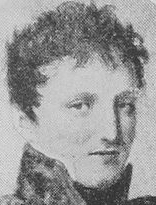General Jean Baptiste Pierre Semellé

Born: June 16, 1773
Place of Birth: Metz, Moselle, France
Died: January 24, 1839
Place of Death: Courcelles-Chaussy, France
Arc de Triomphe: SEMELE on the west pillar
Pronunciation:
Volunteering to join the army like many others during the Revolution, Jean Baptiste Pierre Semellé entered the army as a capitaine in the 3rd Battalion of Volunteers of Moselle in August of 1791. A year later he served at the defense of Thionville. Semellé served with the Army of the Center and the Army of the Moselle from 1792 to 1793, and then in 1794 he joined the Army of the Sambre and Meuse. In 1795 he was promoted to chef de bataillon in the 10th Light and two years later in 1797 he joined the Army of Italy. In 1799 Semellé was promoted to chef de brigade of the 20th Light. In May of 1800 he served in the defense of the bridgehead of the Var, and then in June after the campaign concluded he was named commander of Genoa. Semellé then served with various line units and in 1801 he took command of the 24th of the Line.
When the Grande Armée marched east to face Austria in the War of the Third Coalition, Semellé was employed in the Maurice Mathieu's 2nd Division of Marshal Augereau's VII Corps. He served throughout the campaign of 1805 and then in 1806 he joined Heudelet's division. In December of 1806 Semellé served at Golymin where he was wounded by a shot and then in February of 1807 he served at the Battle of Eylau where he was badly wounded. Nevertheless, he was attached to Dupont's division and he served at Braunsberg later that month. In June Semellé took part in the Battle of Friedland where he was again wounded. Afterwards he was promoted to général de brigade.
In 1808 Semellé was named a Baron of the Empire and then sent to Spain as chief of staff to Victor's I Corps. While in Spain he served at Cuenca and then in the Army of the Center and in Andalusia. Semellé received a promotion to général de division in July of 1811 and he took command of a division in October. He went on to serve at the attack of the camp of Saint-Roch and he tried to make a reconnaissance of Tarifa but was unsuccessful. On November 5th, Semellé won at Bornos near the camp of Saint-Roch, but at the end of the month he was replaced in command due to sickness. In February of 1812 he returned to duty, taking command of a division in the Army of Andalusia. Next Semellé commanded the line of blockade before Cadiz from April to August of 1812, and then in early 1813 he returned to France. He served in the campaigns in Germany of 1813 and that July he took command of the 52nd infantry division under Augereau. Semellé fought at the Battle of Leipzig in October and then in November he took command of the 51st infantry division in IV Corps.
After Napoleon's abdication and the Bourbon Restoration, Semellé was named a Knight of Saint Louis and inspector general of infantry for the 18th and 19th military divisions. He also was named a Knight of the Iron Crown at some point during his army service. When Napoleon returned from exile and resumed power for the Hundred Days, Napoleon placed Semellé in charge of Strasbourg. After the Second Restoration, Semellé was put on non-activity but he later had a career in politics.
Bibliography
- Divry, Arnauld. Les Noms Gravés sur l'Arc de Triomphe. Paris: L'Harmattan, 2017.
- Six, Georges. Dictionnaire Biographique des Généraux & Amiraux Français de la Révolution et de l'Empire (1792-1814). 2 vols. Paris: Gaston Saffroy, 2003.
Updated March 2018
© Nathan D. Jensen